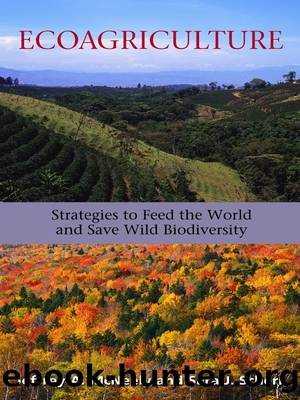Ecoagriculture by Future Harvest & Sara J. Scherr

Author:Future Harvest & Sara J. Scherr [McNeely, Jeffrey A.]
Language: eng
Format: epub
ISBN: 9781610910620
Publisher: Island Press
Published: 2012-08-28T00:00:00+00:00
EXAMPLE 28. TREES IN COSTA RICAN PASTURES FEED FOREST BIRDS
Central America has more than 9 million hectares of land in silvipastoral systems (pastures with scattered trees). Depending on farm size and where a particular plot of land is in the fallow cycle, dispersed trees on farms may be established from an improved fallow, through strategic clearing of a mature fallow, or (where no fallow is used) through direct planting or protection of naturally regenerated trees (Kowal 1999). Farmers keep the trees intentionally in their pastures because of significant benefits to associated livestock, subsistence needs, and income benefits. It is estimated that in Central America as a whole, trees in pastures could produce 18.4 million cubic meters of timber per year, given adequate support for timber marketing and assistance to farmers in tree management (Beer, Ibrahim, and Schlonvoigt 2000). Research has begun to show that such isolated trees also play a critical role in maintaining wild biodiversity, by serving as nesting, feeding, and roosting sites for a variety of bird and bat species, many of which are forest species, and by providing transient habitats for many neotropical migratory birds. Remnant trees in pastures often retain rich communities of epiphytic plants that would not otherwise be present in the agricultural landscape. They assist in forest regeneration, both because they produce seed locally and because the birds and bats that visit their canopies regurgitate or defecate seeds of forest plants while perched in the trees. In addition, the microclimatic conditions (for example, low light levels and high humidity) beneath tree crowns help facilitate the germination, survival, and growth of forest plants.
A survey of twenty-four small-scale dairy farms near Monteverde, Costa Rica, found a mean density of 25 trees per hectare; primary forest trees accounted for 57 percent of all species and a third of all individuals. Many of the tree species are important locally for humans as sources of timber (37 percent), firewood (36 percent), or fence posts (20 percent). Timber, shade for cattle, fruits for birds, and fence posts were the most commonly cited of nineteen reasons for keeping the trees. More than half the farmers interviewed thought that the presence of trees in their pastures improved their farm productivity, whereas 32 percent felt the trees had a beneficial effect in the dry season (conserving moisture) but could be negative in the wet season if they produced too much shade. The remaining 13 percent thought the trees had no effect on productivity. The biodiversity impacts were significant. More than 90 percent of the species are known to provide food for forest birds, bats, and other animals. Their presence is especially important for forest birds (such as three-wattled bellbirds, resplendent quetzals, and keel-billed toucans) that seasonally move from the Monteverde Reserve Complex down to the Pacific lowlands. Since most of the landscape surrounding the Monteverde Reserve Complex is highly deforested, isolated trees in pastures provide essential food sources at various elevations along the birdsâ migratory path (Harvey and Haber 1999).
Download
This site does not store any files on its server. We only index and link to content provided by other sites. Please contact the content providers to delete copyright contents if any and email us, we'll remove relevant links or contents immediately.
| Automotive | Engineering |
| Transportation |
Whiskies Galore by Ian Buxton(41529)
Introduction to Aircraft Design (Cambridge Aerospace Series) by John P. Fielding(32888)
Small Unmanned Fixed-wing Aircraft Design by Andrew J. Keane Andras Sobester James P. Scanlan & András Sóbester & James P. Scanlan(32573)
Craft Beer for the Homebrewer by Michael Agnew(17933)
Turbulence by E. J. Noyes(7700)
The Complete Stick Figure Physics Tutorials by Allen Sarah(7137)
Kaplan MCAT General Chemistry Review by Kaplan(6595)
The Thirst by Nesbo Jo(6435)
Bad Blood by John Carreyrou(6274)
Modelling of Convective Heat and Mass Transfer in Rotating Flows by Igor V. Shevchuk(6222)
Learning SQL by Alan Beaulieu(6035)
Weapons of Math Destruction by Cathy O'Neil(5829)
Man-made Catastrophes and Risk Information Concealment by Dmitry Chernov & Didier Sornette(5646)
Digital Minimalism by Cal Newport;(5389)
Life 3.0: Being Human in the Age of Artificial Intelligence by Tegmark Max(5184)
iGen by Jean M. Twenge(5161)
Secrets of Antigravity Propulsion: Tesla, UFOs, and Classified Aerospace Technology by Ph.D. Paul A. Laviolette(4990)
Design of Trajectory Optimization Approach for Space Maneuver Vehicle Skip Entry Problems by Runqi Chai & Al Savvaris & Antonios Tsourdos & Senchun Chai(4839)
Electronic Devices & Circuits by Jacob Millman & Christos C. Halkias(4748)
